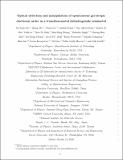Spontaneous gyrotropic electronic order in a transition-metal dichalcogenide
Author(s)
Xu, Suyang; Ma, Qiong; Gao, Yang; Kogar, Anshul; Zong, Guo; Mier Valdivia, Andrés M.; Dinh, Thao H.; Huang, Shin-Ming; Singh, Bahadur; Hsu, Chuang-Han; Chang, Tay-Rong; Ruff, Jacob P. C.; Watanabe, Kenji; Taniguchi, Takashi; Lin, Hsin; Karapetrov, Goran; Xiao, Di; Jarillo-Herrero, Pablo; Gedik, Nuh; ... Show more Show less
DownloadTiSe2_Main_Nature-2018-09-13443.pdf (2.495Mb)
Publisher Policy
Publisher Policy
Article is made available in accordance with the publisher's policy and may be subject to US copyright law. Please refer to the publisher's site for terms of use.
Terms of use
Metadata
Show full item recordAbstract
Chirality is ubiquitous in nature, and populations of opposite chiralities are surprisingly asymmetric at fundamental levels. Examples range from parity violation in the subatomic weak force to homochirality in biomolecules. The ability to achieve chirality-selective synthesis (chiral induction) is of great importance in stereochemistry, molecular biology and pharmacology. In condensed matter physics, a crystalline electronic system is geometrically chiral when it lacks mirror planes, space-inversion centres or rotoinversion axes. Typically, geometrical chirality is predefined by the chiral lattice structure of a material, which is fixed on formation of the crystal. By contrast, in materials with gyrotropic order electrons spontaneously organize themselves to exhibit macroscopic chirality in an originally achiral lattice. Although such order—which has been proposed as the quantum analogue of cholesteric liquid crystals—has attracted considerable interest no clear observation or manipulation of gyrotropic order has been achieved so far. Here we report the realization of optical chiral induction and the observation of a gyrotropically ordered phase in the transition-metal dichalcogenide semimetal 1T-TiSe₂. We show that shining mid-infrared circularly polarized light on 1T-TiSe₂ while cooling it below the critical temperature leads to the preferential formation of one chiral domain. The chirality of this state is confirmed by the measurement of an out-of-plane circular photogalvanic current, the direction of which depends on the optical induction. Although the role of domain walls requires further investigation with local probes, the methodology demonstrated here can be applied to realize and control chiral electronic phases in other quantum materials.
Date issued
2020-02Department
Massachusetts Institute of Technology. Department of PhysicsJournal
Nature
Publisher
Springer Science and Business Media LLC
Citation
Xu, Su-Yang et al. "Spontaneous gyrotropic electronic order in a transition-metal dichalcogenide." Nature 578, 7796 (February 2020): 545–549 © 2020 The Author(s)
Version: Author's final manuscript
ISSN
0028-0836
1476-4687